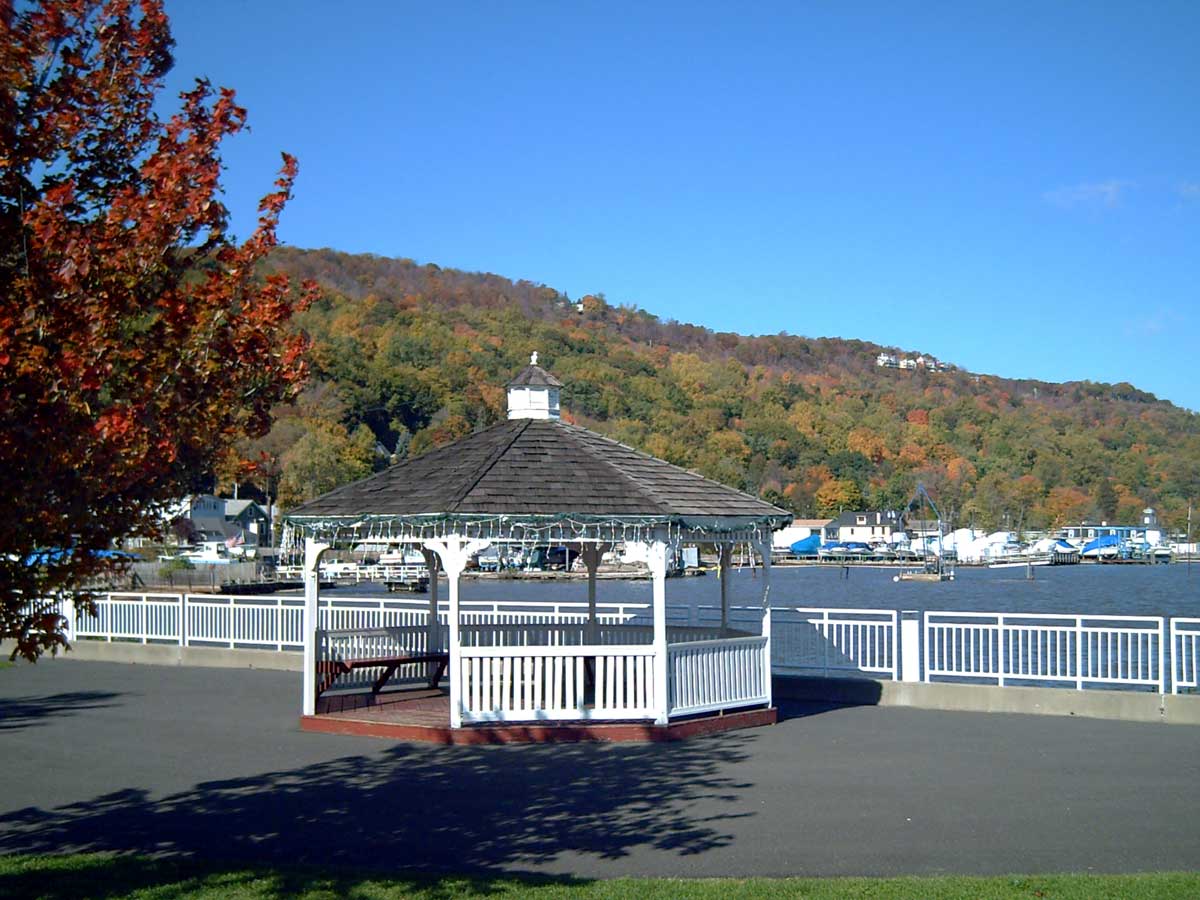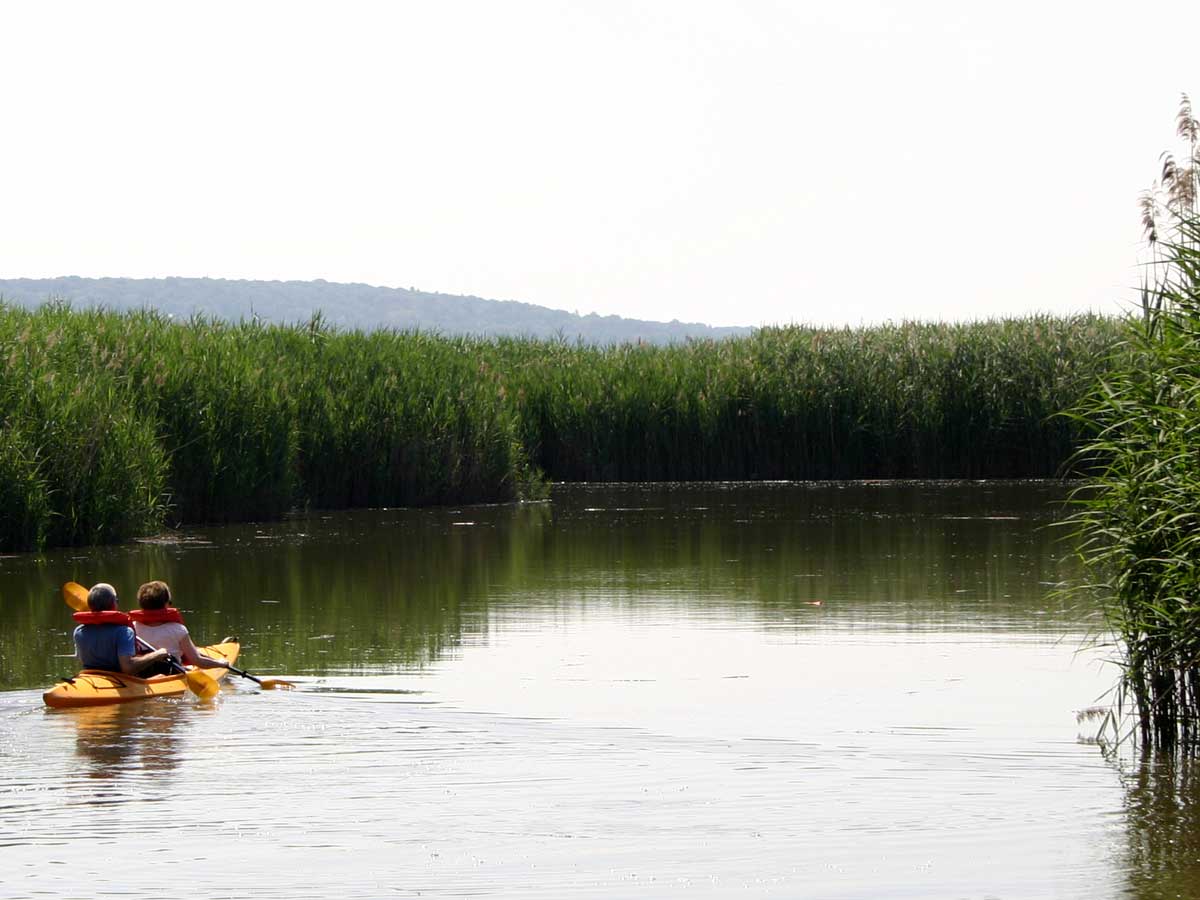The Onderdonk House
Address: 758 Piermont Avenue
This c. 1737 structure is an outstanding example of lower Hudson Valley domestic architecture, illustrating the regional preference for native stone construction in the 18th and early 19th century. It is also representative of the transition between Dutch and English building practices. In May 1783, General George Washington and Sir Guy Carlton, the Commander of the British forces in New York, met at the Onderdonk House before they went to the Dewitt House in Tappan, NY to negotiate the withdrawal of the British forces from New York City. Upon returning to the HMS Perseverance, docked near the Onderdonk House, Sir Carlton honored General Washington with a 17 gun salute recognizing America’s nationhood for the first time. (See stone marker describing the event)
The Flywheel
Address: Flywheel Park, Ash Street
You’d hardly know it today, but for three-quarters of a century, Piermont was truly a “factory town”. The Piermont Paper Company started production in February 1902. In 1920, it was bought by the Robert Gair Company of Brooklyn, which had developed new ways of folding paperboard into cartons. Three major owners followed, including Continental Can, Federal Paperboard, and Clevepak. In the early 1980’s, factory operations ceased, and the Piermont Landing Development Corporation purchased the site. The flywheel was scheduled to be demolished along with the paper factory that housed it, but it was built too well, and the wrecker’s ball just bounced off. It stubbornly remains today as a reminder of the Village’s early beginnings – a fine example of industrial art and a fitting tribute to Piermont’s industrial past. (See information sign on site)
Last Stop USA & the Watch Fires
Address: Piermont Pier
During World War II, the pier was the embarkation point for over one and a half-million GIs who would fight in the European theater, and at the end of the war, the debarkation point of nearly half a million returning. The Watch Fires begun in 1987 by the Rockland County Vietnam Veterans, are lit here on Memorial weekend. They commemorate the fires General Washington lit atop the Palisades to warn of the movement of the British Army and signaled the cease fire ending the Revolutionary War. (see war memorial plaques at the flagpole on site)
The Drawbridge
Address: Bridge Street
Located just past the Post Office and built in 1880 by the King Iron Bridge Company, the bridge is a single leaf, manually operated metal drawbridge that was raised to allow marine traffic to pass on the Sparkill Creek. It is listed on the National Register of Historic Places. (See the cast-iron plaque mounted above the portal)
Rockland Road Bridge Historic District
Address: Rockland Road between Ferdon Avenue and South Piermont Avenue
Known as “The Birthplace of Piermont”, this is the oldest and most historic area of Piermont and many of the surrounding buildings have maintained their 19th century character. Listed on The National Register of Historic Places, the oldest house in Piermont is here and once hosted George Washington. The district is on the National Register of Historic Places. (See informational sign on the bridge describing the district)
Haddock’s Hall
Address: Ferdon Avenue and Rockland Road
Known locally as the Silk Mill, the hall was built in 1876 and listed in 1990 on the National Register of Historic Places. It is historically and architecturally significant as a rare example of a combination of civic and commercial use. Haddock’s Hall and the creek were the center of the Village until the arrival of the railroad, serving at times as a general store, music hall, and library. Hasbrouck Motor Works, a manufacturer of yacht motors was established in 1900. It was also used for village meetings. By the mid-1920’s silk fabric was being spun. Over the years, it produced silk ribbon and narrow fabric strips for hat bands, laces, corset bindings, parachute rip cords, and the narrow stripe down formal trousers. During World War II, medals awarded to soldiers hung from striped ribbons made in Piermont. Today it is a private residence.
The Mine Hole District and The Mine Hole
Address: South Piermont Avenue
The Mine Hole is the name of a mine as well as a district in Piermont that runs from Rockland Road Bridge to Valentine Avenue on the north side of the creek. African Americans inhabited this area long before the Revolution. The Mine Hole itself (across from 175 S. Piermont Ave) is still a mystery as it is unknown who built it and when. Neither is it known who inscribed the Henry Wadsworth Longfellow poem above the entrance. In the early 20th century, there was a freshwater spring for people and horses. In the early 1970s, a new concrete portico and fence were installed, and the sign was restored in recognition of the site’s historic importance.
JFK Memorial Park and the GI Joe Statue
Address: Piermont Avenue and Paradise Avenue
This park is where the annual Memorial Day observations and other civic events are held and is located on the WWII GI’s route to the pier and embarkation to European Theatre war zones. Note the cannon. Found in the river many years ago by local kids, it is believed to be of Revolutionary War vintage.
The Piermont Train Station
Address: Ash Street and Hudson Terrace
Listed on the National Register of Historic Places, this 1883 station was restored by the Piermont Historical Society and is now a museum of the history of Piermont. It is the only known remaining station of its kind. For over 50 years, stationmaster Belle Kelly was the telegrapher and ticket agent servicing, at times, more than 40 trains a day. Railroad traffic that ran from Jersey City to Nyack ended in 1966 and the tracks were removed to create the bucolic Erie Path. (See the informational sign in front of the station.)
Fort Comfort Inn & Resort
Address: At Pier 701 and Buena Vista Drive
Fort Comfort Inn and Resort an early 1900s tourist attraction, advertised as a place with “…high-class service, beautiful surroundings, caters especially to tourists; open all year…” The resort even offered night swimming with a lighted area for safety. All that remains of the popular attraction are two sets of puddingstone pillars and a crenellated battlement located on Buena Vista Drive off Piermont Ave.
Piermont’s Pier and the NY & Erie Railroad
Address: The pier & landfill east of Piermont Avenue
The NY & Erie created a massive 90-acre landfill and a one-mile long pier to build its railroad and ensure that steamboats from Manhattan had sufficient high water to dock. The NY & Erie was the first major RR in the US and, in 1851, the longest in the world, traveling 447 miles from the pier to Lake Erie. Today, the pier and this landfill, encompassing Flywheel Park, the restaurants, galleries, shops and Ferry Road, are major attractions. (See the NY & Erie informational sign at the end of the pier)



